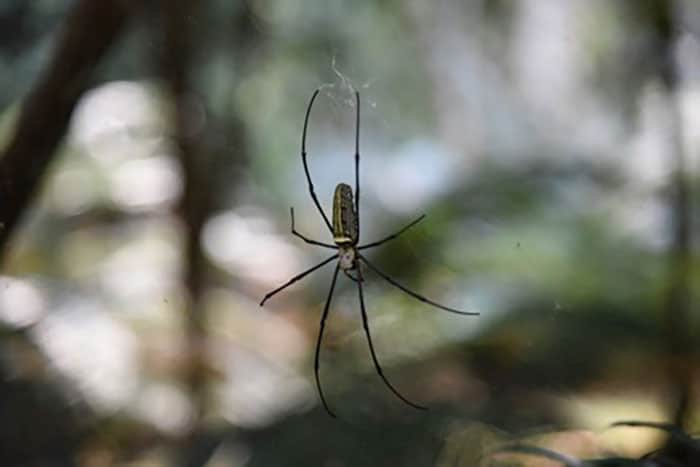Simulations shed light on interactions that help spiders fly
15 Mar 2022

Simulations using a computer graphics algorithm have given fresh insight into the interactions between the silk threads of a spider and the atmosphere. This novel numerical model, focusing on multiple silk threads, helps explain how spiders can exploit the positive electric potential of Earth’s atmosphere to fly and disperse.
Even though they do not have wings, some spiders can fly. They emit fine threads of silk and float through the air attached to them, a process known as ballooning. Scientists have been writing about this unusual dispersal behaviour since at least the 1600s – Charles Darwin even observed hundreds of ballooning spiders landing on the HMS Beagle when it was 60 miles offshore – but no one is quite sure how it works.
There are two competing theories to explain spider ballooning. The first suggests that rising warm air, created by thermal gradients as the sun heats the Earth’s surface, drags on the light silk threads and pulls the spider upwards. The other proposes that negative electrostatic charges on the spider’s silk threads interact with the positive electric potential of Earth’s atmosphere. This creates an electrostatic buoyancy that lifts the threads and with them the spider – if the conditions are right.
In this latest study – described in Physical Review E – Charbel Habchi from Notre Dame University-Louaize in Lebanon and M Khalid Jawed of the University of California, Los Angeles, develop a new numerical model that they claim provides evidence for the role of electrostatic forces in ballooning. Previous simulations attempting to explore ballooning have modelled spiders with single silk threads. But spiders often balloon with multiple threads. This could alter the ballooning process as electrostatic repelling forces between the threads may affect their shape and distribution, impacting the way they interact with and move through the air.
To address these concerns, Habchi and Jawed used a computer graphics algorithm known as “discrete elastic rods” to model the ballooning of spiders due to electrostatic forces. Their 3D numerical simulation models multiple threads on a single spider and accounts for viscous forces, the weight and dimensions of the threads and spider, electrostatic lift and repelling forces, and the elastic bending force of the threads.
Habchi tells Physics World that at the start of the simulation the spider is on the ground and the silk threads are oriented vertically. As the spider lifts, the shapes of the silk threads change with time under the influence of gravity, the electrostatic interaction between the Earth’s electric field and the charge on the threads, and the hydrodynamic force exerted on the threads by air. “In addition, we highlight the importance of the Coulomb repelling forces in avoiding entanglement – the silks repel each other and, therefore, do not get tangled up,” Habchi explains.
These different interactions – particularly the repelling forces – cause the threads to bend and spread out, together forming a 3D, upside-down cone-like shape. The drag created by this conical shape acts against the electrostatic lifting force and determine the spider’s terminal upward velocity. The modelling showed that terminal ballooning velocity decreases linearly with the lift force.
To account for different ways that electric charge could be distributed on a silk spider thread, the researchers ran simulations with a uniform charge distribution along the threads, and with the electric charge concentrated at the thread tips. The results were similar for both.READ MORE

“We show that small spiders can use the Earth’s electric field to balloon without the need of uplift thermal currents or wind,” says Habchi. “However, large spiders cannot balloon solely due to electric charge and need airflow or thermal currents.” He adds that more observational data from spiders in flight, while measuring the atmospheric charge, wind and other environmental factors, would be helpful to understand this process.
A better understanding of spider blooming could also have biomimetic applications. “The understanding of spider ballooning would be beneficial for the design of ballooning sensors based on a similar concept for the exploration of the Earth’s atmospheric properties,” Habchi tells Physics World.
Michael Allen is a science writer based in the UK.
from physicsworld.com 23/4/2022
Δεν υπάρχουν σχόλια:
Δημοσίευση σχολίου